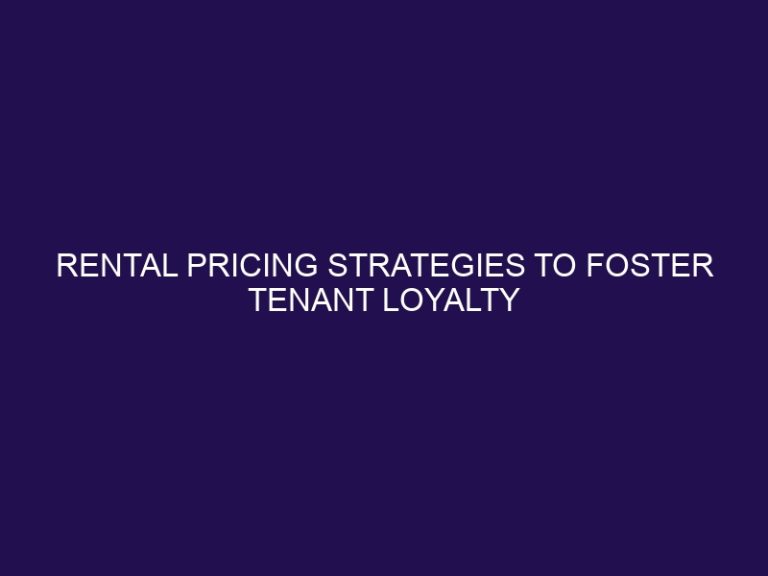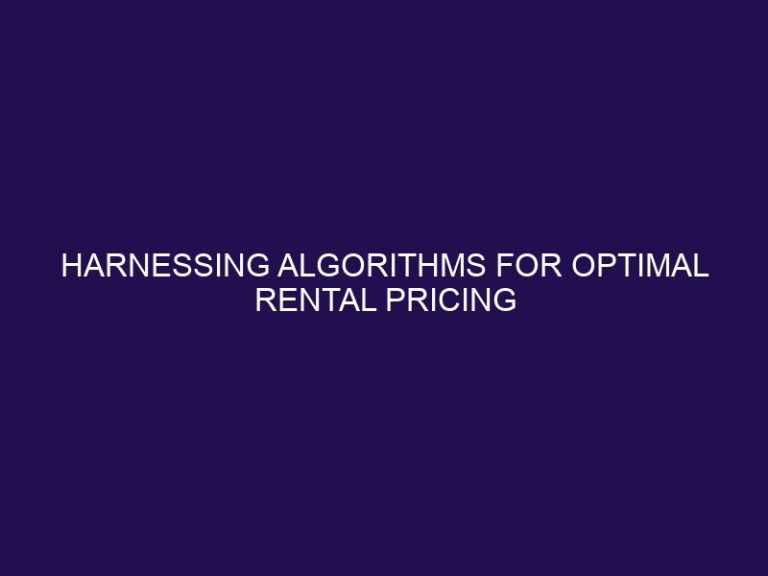Landlord Guide: How Much Should I Charge For Rent?
Setting the right rent for your rental property is crucial as it directly impacts your profitability and attracts potential tenants. Determining the optimal rental amount requires careful consideration of various factors. Here are the key factors to consider when determining rent:
- Location: The location of your property plays a significant role in determining its rental value. Factors such as proximity to amenities, transportation, schools, and job opportunities can influence the rental demand and prices in the area.
- Property Size and Amenities: The size of the property, number of bedrooms, bathrooms, and additional amenities like parking spaces, laundry facilities, or a backyard can affect the rental value. Larger properties or those with desirable amenities typically command higher rent.
- Market Conditions: The current market conditions, including supply and demand dynamics, vacancy rates, and rental trends, will impact the rent you can charge. Conducting market research can provide valuable insights into the prevailing rental rates in your area.
- Comparable Rental Properties: Analyzing similar rental properties in your neighborhood can help you understand the competition and set a competitive rent. Look for properties with similar size, features, and location to gauge the market rate.
Methods for calculating rent can vary depending on various factors. Here are several commonly used methods:
- Percentage of Property Value: Some landlords calculate rent as a percentage of the property’s value. This approach is commonly used for commercial properties.
- Rent per Square Foot: Determining rent based on the size of the property is common for residential properties. Rent per square foot can vary significantly based on factors such as location, property condition, and amenities.
- Gross Rent Multiplier: Applicable for investment properties, the gross rent multiplier considers the property’s purchase price and projected rental income to determine the rent.
- Income Approach: This method estimates the rent based on the property’s potential income and prevailing market capitalization rates.
Additional considerations when setting rent include additional expenses like utilities and maintenance, understanding rental market dynamics, and complying with legal requirements and rent control regulations.
To assist in determining the appropriate rent for your property, you can utilize various tools and resources, such as online rent calculators, consulting with real estate agents or property managers, and conducting market research and comparative analysis. Taking these factors and resources into account will help you set a fair and competitive rental price for your property.
Factors to Consider When Determining Rent
When determining how much to charge for rent, several factors come into play. From location and property size to market conditions and comparable rental properties, each aspect influences the final decision. Consider the desirability of the area, the amenities offered, and even the current market trends. By analyzing these elements, landlords can arrive at a fair rental price that balances profitability with competitive rates. So, let’s dive into these key factors and discover how they shape the rent you should charge.
Location
Location is a crucial factor to consider when determining rent for a property. The location of a rental property greatly influences its desirability and attractiveness to potential tenants. Properties located in prime areas such as city centers or near amenities like schools, shopping centers, and transportation hubs tend to command higher rents. On the other hand, properties in less desirable or remote locations may have lower rental values. Therefore, landlords need to carefully assess the location of their property and research the rental market in that specific area to accurately set the rent that reflects the property’s location value.
In the 1800s, during the California Gold Rush, the town of Coloma experienced a rapid increase in demand for housing due to its proximity to the gold mines. Landlords in Coloma capitalized on the prime location by charging exorbitant rents for simple dwellings. The high demand and limited supply of housing allowed landlords to set the rent at astronomically high rates, making it difficult for prospectors to afford decent accommodations. This historical example highlights the significant impact that location has on rental prices.
Property Size and Amenities
When determining rent for a property, the size and amenities of the property play a crucial role. Consider the following when setting the rent:
- Property Size: Larger properties typically command higher rents due to the increased living space they offer.
- Amenities: Properties with attractive amenities like a pool, gym, or laundry facilities may justify a higher rent due to the added convenience and value they provide.
- Condition: Well-maintained and updated properties with modern amenities may justify a higher rent as they offer a better living experience.
Pro-tip: Conduct market research to compare similar properties in the area to ensure your rent is competitive and reflective of the property’s size and amenities.
Market Conditions
Market conditions play a vital role in determining the appropriate rent for a property. It is crucial for landlords to remain well-informed about the present state of the rental market in their specific area. Factors like supply and demand, vacancy rates, and economic indicators can heavily impact rental prices. Additionally, landlords should take into account whether the market is currently favorable to tenants or landlords, as this factor can significantly influence their pricing strategies. By analyzing market conditions, landlords can effectively establish competitive rents, attract tenants promptly, and maximize their rental income. To stay updated, it is advisable to review local real estate reports, seek professional advice, and utilize online tools to evaluate market conditions and make well-informed decisions.
Comparable Rental Properties
When determining the rent for a property, it is crucial to consider comparable rental properties in the market. By analyzing what similar properties are renting for, landlords can ensure that their rent is competitive and reasonable.
Here is an example of a table that compares rental properties:
| Property | Location | Number of Bedrooms | Monthly Rent |
| Property 1 | City A | 2 | $1,500 |
| Property 2 | City A | 3 | $1,800 |
| Property 3 | City B | 2 | $1,700 |
By studying the rent prices of comparable rental properties similar in location and size, landlords can set a competitive rent for their own property, ensuring that it is attractive to potential tenants and aligns with the current market rates.
Sarah, a landlord in City A, wanted to determine the rent for her newly renovated two-bedroom apartment. She researched comparable rental properties in the area and found that similar apartments were renting for around $1,500 to $1,800 per month. Based on this information, she decided to set the rent for her apartment at $1,600. Within a week, she had multiple interested tenants and was able to find a reliable tenant quickly.
Methods for Calculating Rent
Looking to determine the ideal rent for your property? Dive into the various methods for calculating rent in this section. From analyzing the percentage of property value to evaluating rent per square foot, we’ll explore the factors that come into play. Discover the insights behind the Gross Rent Multiplier and the Income Approach, giving you the tools to make informed decisions. Get ready to unlock the strategies that will help you maximize your rental income.
Percentage of Property Value
One method for determining rent is by using the percentage of the property value. This involves calculating a certain percentage of the property’s overall value and setting the rent accordingly. The specific percentage used can vary depending on factors such as location, demand, and market conditions. For example, in a highly desirable area with strong demand, landlords may choose to set the rent at a higher percentage of the property value. Conversely, in a less desirable area or during a sluggish rental market, a lower percentage may be used. Ultimately, the goal is to strike a balance that maximizes rental income while attracting and retaining tenants.
| Method for Calculating Rent |
|---|
| Percentage of Property Value |
| Rent per Square Foot |
| Gross Rent Multiplier |
| Income Approach |
Rent per Square Foot
Rent per Square Foot is a common method used to calculate rental prices based on the size of the property. By dividing the total rent by the total square footage, landlords can determine a fair price per unit of space. Various factors such as location, amenities, and market conditions can influence the rent per square foot. It is important for landlords to take into account the average rent per square foot in their area and compare it to similar rental properties to ensure competitiveness. Utilizing online rent calculators and seeking advice from real estate agents or property managers can offer valuable insights when determining the rent per square foot.
Gross Rent Multiplier
The gross rent multiplier (GRM) is a useful tool used by real estate investors to determine the value of a property based on its rental income. It is calculated by dividing the property’s purchase price by the gross annual rental income. A lower GRM indicates a better investment opportunity. When considering factors such as location, size, and market conditions, the GRM can help investors assess the potential income and return on investment. Other methods for determining rent include percentage of property value, rent per square foot, and the income approach. The GRM provides a simple and effective way to analyze rental property value.
| Method | Formula | Advantages |
| Gross Rent Multiplier | Purchase Price / Gross Annual Rental Income | Quick and easy to use, provides a snapshot of property value |
| Percentage of Property Value | Rental Income / Property Value | Considers income as a percentage of property value |
| Rent per Square Foot | Rental Income / Square Footage | Focuses on the property’s size and earning potential per square foot |
| Income Approach | Net Operating Income / Capitalization Rate | Takes into account expenses, vacancy, and capitalization rate |
Income Approach
The income approach, also known as the Income Approach, is a method commonly used by landlords to determine rental rates based on the potential income that a property can generate. It takes into account various factors including the property’s market value and the projected rental income. By utilizing this approach, landlords are able to establish rent prices that are in line with the property’s earning potential. To calculate the rental income using the Income Approach, landlords must estimate the property’s vacancy rate and deduct any anticipated expenses such as property management fees and maintenance costs. This practical method, the Income Approach, enables landlords to set competitive rents that reflect the property’s income-generating capacity. It is recommended to utilize this approach alongside market research and comparative analysis to ensure that your rental rates are fair and attractive to potential tenants.
Additional Considerations When Setting Rent
Setting the right rent for your property involves more than just crunching numbers. In this section, we’ll explore the additional considerations that play a crucial role in determining rental prices. From the impact of additional expenses to the ever-changing dynamics of the rental market, we’ll uncover important factors that can guide your decision-making process. We’ll also touch upon legal requirements and the potential implications of rent control measures. So, let’s dive into these key aspects to ensure that your rental pricing strategy is well-informed and effective.
Additional Expenses
When determining rent for a property, it’s crucial to consider all additional expenses that may arise. These additional expenses can have a substantial impact on the overall profitability of the rental property. Here are some factors to take into account:
-
Maintenance and Repairs: It is inevitable to have regular maintenance and unexpected repairs. Budgeting for these expenses is essential to maintain the property’s good condition.
-
Insurance: Landlords should have sufficient insurance coverage to safeguard against property damage, liability claims, and loss of rental income.
-
Property Management Fees: If you decide to hire a property management company, make sure to factor in their fees while determining the rental price.
-
Utilities: Depending on your agreement with tenants, there may be certain utilities for which you are responsible, such as water, electricity, or gas.
-
Property Taxes: Property taxes can significantly influence the rental property’s profitability. It is imperative to consider this expense when setting the rent.
-
Vacancies and Marketing: It’s crucial to budget for periods when the property may be vacant, as well as expenses related to advertising and finding new tenants.
In the 18th century, landlords in England used to incorporate “additional expenses” for extravagant furnishings and lavish parties into the rent. These expenses were intended to showcase the landlord’s wealth and social status, but they burdened tenants with exorbitant costs. Nowadays, landlords must be transparent about additional expenses and ensure that they are reasonable and necessary.
Rental Market Dynamics
Rental market dynamics are a paramount factor when it comes to determining the appropriate rental rate for a property. It is crucial for landlords to have a thorough understanding of these dynamics in order to make well-informed decisions. Supply and demand, vacancy rates, and rental trends in the area are all key factors that have a significant impact on rental prices. Additionally, economic conditions and demographic changes can also exert influence on the rental market. It is imperative for landlords to stay updated with market fluctuations and make necessary adjustments to their rental rates in order to attract tenants and maximize profitability. By conducting comprehensive market research and comparative analysis, valuable insights into rental market dynamics can be gained, enabling landlords to establish competitive rental prices.
Legal Requirements and Rent Control
When establishing the rental price for your property, it is essential to take into account legal requirements and rent control regulations. These aspects vary depending on your location and can have a significant impact on your rental income and relationships with your tenants. It is important to familiarize yourself with the local laws concerning rent increases, eviction procedures, security deposit limits, and fair housing regulations. In areas where rent control is implemented, there may be limitations on the annual rent increment. By staying informed about and adhering to these legal requirements, you can avoid legal consequences and foster positive landlord-tenant relationships.
Now, here’s an intriguing historical fact: Back in 1943, New York City introduced the nation’s first comprehensive rent control law in response to a housing shortage during World War II. This law aimed to protect tenants from excessive rent hikes and brought stability to the rental market. Rent control laws have since evolved in different cities and states to cater to the needs of tenants and ensure the availability of affordable housing.
Tools and Resources to Help Determine Rent
Looking to determine the optimal rent for your property? Look no further! We’ve got you covered with a range of invaluable tools and resources. From online rent calculators to real estate agents and property managers, to the power of market research and comparative analysis, we’ll explore all the tools at your disposal. Get ready to make informed decisions and set the perfect rent price that will attract tenants and maximize returns. Let’s dive in!
Online Rent Calculators
- Online rent calculators, such as the ones specific to your country or region, can be a helpful tool for both landlords and tenants in determining fair rental prices.
- When using these online rent calculators, enter all the necessary information, including the location, property size, amenities, and market conditions.
- Don’t forget to consider additional factors that may affect the rental price, such as the demand for similar properties in the area.
- Review the suggested rental price provided by the online rent calculator, but always keep in mind that it is only a starting point.
- Take into account other factors like local rental market dynamics and legal requirements, in addition to using the calculated price as a reference point.
Online rent calculators have become increasingly popular in recent years due to their convenience and accessibility. They offer a quick and easy way to estimate rental prices based on a variety of factors. Landlords can utilize these online rent calculators to set competitive rates, while tenants can use them to negotiate fair rents. With continuous advancements in technology, these calculators are evolving to provide more accurate estimations, thereby making the rental process more transparent and efficient for everyone involved.
Real Estate Agents and Property Managers
- Market Knowledge: Real estate agents and property managers, also known as real estate professionals, possess a wealth of knowledge about the local rental market. They can provide valuable insights into current rental trends, vacancy rates, and the prevailing rental prices within the area.
- Property Evaluation: These experts have the ability to evaluate your property thoroughly and determine its rental potential. Factors such as location, size, amenities, and overall condition are taken into account to provide an accurate assessment.
- Pricing Strategy: With their extensive expertise, real estate agents and property managers can assist you in formulating an optimal rent for your property. They carefully consider market demand, competition, and the unique features of your property to determine the best possible pricing strategy.
- Marketing and Advertising: The valuable connections and marketing resources at the disposal of real estate agents and property managers enable them to effectively promote your property to potential tenants. They utilize their networks and leverage various marketing techniques to attract suitable tenants for your rental property.
- Tenant Screening: Entrusting the task of tenant screening and background checks to these professionals ensures that you find reliable and trustworthy tenants. They employ rigorous screening processes to identify the most suitable candidates for your property, minimizing the risk of complications in the future.
- Lease Agreements: Real estate agents and property managers are well-versed in drafting lease agreements and ensuring legal compliance. Their expertise in this area is crucial for safeguarding your interests as a landlord and protecting you from any potential legal issues that may arise.
- Property Maintenance: Additionally, property managers have the ability to handle routine maintenance and repairs. This ensures that your property remains well-maintained and appealing to tenants, ultimately maximizing its desirability and rental potential.
By harnessing the knowledge and skills of real estate agents and property managers, you can streamline the rental process and optimize the profitability of your property.
Market Research and Comparative Analysis
Market research and comparative analysis play a vital role in determining the appropriate rent for a property. They involve conducting thorough research and analyzing data on rental prices in the local market, thereby gaining insights into current trends and demands. This information becomes crucial for landlords as it enables them to set competitive rent that not only attracts tenants but also maximizes their profit. To conduct a comparative analysis, factors such as location, property size, amenities, and condition are taken into consideration, ensuring that a fair rental price is determined. Additionally, this analysis helps in identifying unique features or advantages of the property that may justify a higher rent. By incorporating market research and comparative analysis into their decision-making process, landlords can make well-informed choices and set rents that are in line with the current rental market.
Frequently Asked Questions
1. How do I determine how much to charge for rent?
To determine how much to charge for rent, you can follow the rule of thumb of calculating 1 percent of your property value. Additionally, conducting a market analysis of similar rentals in your area and considering factors such as square footage, number of bedrooms and bathrooms, and rental prices in the area can help you determine the ideal rent amount.
2. What is the Zillow rent estimate and how accurate is it?
The Zillow rent estimate is a tool that provides a figure for suitable rent based on factors such as property information, square footage, number of bedrooms and bathrooms, and rent prices in the area. However, its accuracy may vary depending on location. It is recommended to conduct your own assessment and market analysis to validate the rent estimate provided by Zillow.
3. How can I attract good tenants and minimize vacancy periods?
To attract good tenants and minimize vacancy periods, it’s important to set the right rent amount that is competitive in the market. Conducting a rental market analysis allows you to compare your property to similar rentals in terms of various factors like neighborhood rating, property amenities, and recent renovations. Offering desirable features and amenities and ensuring your rent covers operating costs and allows for profit can also help attract good tenants and reduce vacancy periods.
4. What factors should I consider before renting out my property instead of selling it?
Before renting out your property instead of selling it, you should consider factors such as the equity you have in your home, your financial goals, your ability to handle the responsibilities and risks of being a landlord, and the potential expenses involved in turning your home into an investment property, including repairs, property taxes, and maintenance costs. Additionally, you should have a flexible schedule to attend to maintenance issues that may arise and be aware of the financial implications if your tenant suddenly moves out.
5. How does the local and national economic situation impact rental property demand?
The local and national economic situation can have an impact on rental property demand. Factors such as job growth, population growth, and affordability can all influence the demand for rental properties. Additionally, demand may vary by season, with higher demand in the spring and summer. Being aware of these economic factors can help landlords set appropriate rents and maximize their return on investment.
6. Are there any rent control laws I need to be aware of?
It is important for landlords to understand and comply with rent control laws that may exist on a city and state level. Rent control laws can restrict how much landlords can charge for rent and may have specific regulations regarding rent increases and eviction procedures. Familiarizing yourself with these laws will help ensure that you are charging a fair and legal rent amount.







